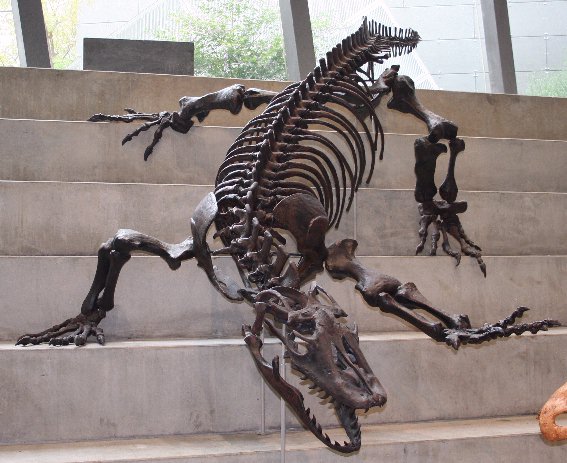Friday, February 21, 2014
The Kumi Lizard
The monitor of Komodo is a dragon indeed. At ten feet long, it's Earth's largest lizard -- and certainly its most dangerous. the Komodo dragon is a mighty predator, capable of taking down water buffalo. This isn't due to strength alone -- the creature is venomous, and can poison its prey with a bite. Impressed? You should be -- the Komodo dragon is truly the king of the lizards. But this crown, as paleontologists know, has been recently earned. Only 30,000 years ago, it belonged to a much larger and deadlier species.
Its name was Megalania. A neighbor of the Komodo dragon, it lived in prehistoric Australia alongside many other extinct species. During the Pleistocene, Australia's animals were huge -- much larger than anything seen there today. Megalania could exceed twenty-three feet; its prey included ten-foot wombats and thousand-pound kangaroos. Around 30,000 years ago, all of these "megafauna" disappeared -- right when humans arrived on the continent. Few scientists think this is a coincidence. A popular theory is that humans overhunted these animals -- driving Megalania to extinction.
But some are convinced that the beast still lives. They point to tales of the "Kumi Lizard" -- a reptilian cryptid of New Zealand. It lives in trees, so it's said, and is about five feet long. The creature has been sighted as recently as the '70s, and is far larger than the island's other lizards. Is Megalania's survival possible? Perhaps, but it's not likely. On the plus side, New Zealand has plenty of undeveloped land, and a giant reptile would not lack for habitat. But on the other hand, what would Megalania eat? There are no giant wombats in New Zealand -- only thousands of sheep, which would surely be noticed if they went missing.
Furthermore, the Kumi Lizard sounds nothing like Megalania. The latter is four times the cryptid's length -- nothing that size could climb a tree. Furthermore, Megalania was not native to New Zealand. Could it have swum there from Australia? Maybe -- several monitor lizards are semi-aquatic. But that's an awfully long distance, and would challenge heavy reptiles.
Unfortunately, Megalania seems to be truly extinct. But that doesn't debunk the Kumi Lizard. There are two other theories that might explain this cryptid, and both of them are far more likely. First of all, the creature might be a crocodile monitor. This species is a powerful swimmer, and lives on nearby New Guinea. It's a much better seafarer than Megalania -- perhaps it once reached New Zealand. Furthermore, it's close to the Kumi in size -- adults can reach reach eight feet, and they're fairly decent climbers.
Alternatively, the Kumi Lizard might be a new species. There are several monitors living in Oceania; an undiscovered type isn't impossible. If such a species existed, it would belong to the genus Varanus. That would make it a smaller cousin of the Komodo dragon -- and, of couse, of Megalania.
Read more about the Kumi Lizard and Megalania
http://nzcryptozoologist0.tripod.com/id20.html
http://www.paranormalinvestigators.org.nz/home.php?page=cryptozoology&id=14
http://picsandstuff.wordpress.com/2011/09/27/the-mysterious-kumi-1898/
http://www.bbc.co.uk/nature/wildfacts/factfiles/3046.shtml
http://animaldiversity.ummz.umich.edu/accounts/Varanus_komodoensis/
Image (of Megalania skeleton, public domain) from http://upload.wikimedia.org/wikipedia/commons/0/07/Varanus_priscus_Melbourne_Museum.jpg
Subscribe to:
Post Comments (Atom)

No comments:
Post a Comment